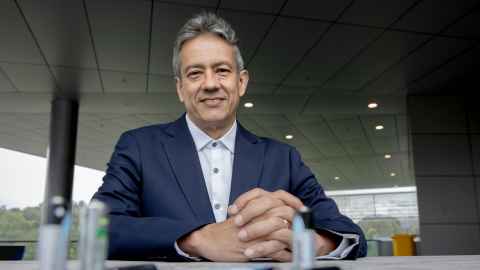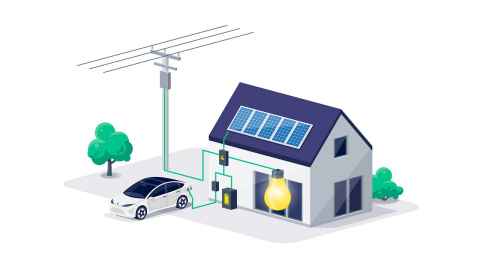Emilson Silva: energising Aotearoa
1 March 2024
As the director of the University’s Energy Centre, Emilson Silva is helping shape the future of energy innovation to meet New Zealand’s economic and environmental needs.

Professor Emilson Silva’s path to becoming a leading energy economist took a comically squeamish detour during his high school years.
Dreaming of donning a doctor’s white coat and stethoscope, Emilson was met with the unsettling reality of a frog dissection in one of his high school classes. The sight of amphibian blood proved too overwhelming, derailing his medical ambitions.
This pivotal moment led the young Brazilian away from medicine and towards the equally complex, but less bloody, world of economics.
It’s a decision that has turned out well. In 2023 he relocated to Aotearoa New Zealand and became director of the Energy Centre at the University. He also holds the position of Chair in Energy Economics at the Business School.
The country’s rich natural resources, both renewable and non-renewable, present an opportunity for pioneering energy transition strategies, says Emilson. He envisions the Energy Centre as a pivotal player in this endeavour, focusing on electricity as the cornerstone of a sustainable future.
Recent research from the centre includes a study exploring ways to enhance New Zealand’s emissions trading scheme. Another dissects New Zealand’s emissions drop of almost three percent between 2007-2013, highlighting lessons for where and how to decarbonise to reach the far more demanding national target of net zero by 2050.
Another study uses Auckland-centric data to show that solar panels are positively associated with electric vehicle uptake.
“I believe we’re on the cusp of a significant shift towards individuals producing their own energy, particularly through solar power,” says Emilson.
“This concept of ‘prosumers’ – people who both produce and consume energy – was something I first encountered in Perth, Australia. There I saw first-hand how families, many not connected to the grid, were generating their own solar energy, with the option to sell excess energy to others in their area.
“While we’re not quite there yet in New Zealand, I see huge potential for this to develop in the near future, leading to greater flexibility in our energy systems.”
Our current regulations, however, are somewhat restrictive, says Emilson, limiting peoples’ ability to trade energy unless they register as retailers.
“I’m optimistic that these regulations will evolve to better facilitate peer-to-peer energy trading, mirroring trends in Australia and other countries. In my view, the move towards decentralised trading is an inevitable and rapidly approaching future for New Zealand’s energy landscape.”

A question we’re all exploring is how to ensure a reliable
energy supply when the wind isn’t blowing, there’s a drought, or the sun isn’t
shining.
Emilson was born in 1964 in Três Corações (three hearts), a Brazilian city that’s known for being the birthplace of football legend Pelé. When he was six, he moved with his family to the country’s newly established capital, Brasilia.
In the mid-1950s, the President of Brazil decided to move the capital city away from Rio de Janeiro, with the intention of building a modern, 21st-century city at the centre of the nation to open the central territories to greater economic development.
Work on the new capital began in 1956, and Brasilia, which was hailed as a modernist miracle in its early days, was inaugurated four years later in 1960.
A number of professionals, including Emilson’s dad, a dentist, were asked to relocate to the new capital. In 1970, the family set up in the meticulously designed city, where Emilson enjoyed school and football in some of the city’s many parks.
Inspired by a fascination for other countries and cultures, Emilson considered careers that would take him overseas, and life as a diplomat piqued his interest.
“I was thinking about how I could live and work in different countries. One of my friend’s fathers was a diplomat and an economist, and my friend said that since I liked history and maths, I would probably like economics, and that studying economics was helpful in terms of becoming a diplomat.
“In my history class, I remember reading a textbook written by an economic historian who provided rationale for historical events based on economics. The book opened my eyes to the economic motivations behind things that had happened, such as wars that had been fought. This was all very interesting to me, and I eventually went on to study economics at the University of Brasilia.”
Emilson graduated in 1986, and that same year, after a mentor told him he didn’t need a masters degree to pursue a PhD in the US, he signed up for his doctoral studies at the University of Illinois.
It turned out that academia was his calling and an excellent way to see the world. Emilson’s first role was as an assistant professor in the Department of Economics at the University of Oregon, where he worked for six years before accepting a position as a senior assistant professor at Tulane University in New Orleans.
“I loved the university there, and I loved the city. It felt like a sister city to a Brazilian one because of the culture, the food, the music and the attitude of the people, who tended to be warm, vibrant and social.”
In 2005, Hurricane Katrina devastated the city and its people. Emilson and around 250,000 others fled the area.
In 2006, he moved to Atlanta, Georgia, where he landed a professorship at the Georgia Institute of Technology. He played a crucial role in developing the economics PhD programme, laying the groundwork for future scholars to explore the nexus of economics and environmental issues.
In 2012, he was invited by a colleague from the University of Alberta to apply for a position.
“They wanted someone to work on energy and environmental issues. At that time, there was a boom in terms of commodities and oil, and they wanted someone to help them with their energy sector, which was mostly fossil fuels.”
Emilson spent nearly 12 years at the University of Alberta, where he held the Campus Alberta Innovation Program Chair in the areas of energy and environmental economics from 2012 to 2019 and was department head from 2018 to 2021.
If you have a very efficient way of preventing CO2 emissions, fossil fuels could be used solely as a backup. This approach could balance sustainability with the need for energy security and price stability.
Emilson says a key concern in New Zealand’s energy sector is energy security, especially as the country increasingly incorporates intermittent renewable sources like wind and solar into its energy mix.
“A question we’re all exploring is how to ensure a reliable energy supply when the wind isn’t blowing, there’s a drought, or the sun isn’t shining.”
Energy storage solutions, such as batteries or natural batteries like the axed Lake Onslow pumped hydro project, become critical in this context, he says.
“Geothermal energy is a good renewable energy source, but efficiency challenges exist. We can also consider the role of hydrogen and the possibility of using thermal plants powered by natural gas or coal as a backup, provided that you have carbon capture and storage available.
“If you have a very efficient way of preventing CO₂ emissions, fossil fuels could be used solely as a backup. This approach could balance sustainability with the need for energy security and price stability.”
The concept of a capacity market, similar to systems in the UK, could provide a structured solution to ensure the availability of backup energy resources during peak demand periods or dry spells, says Emilson, offering long-term security and motivating the maintenance of essential backup infrastructure.
“I think this could be one of the arguments used by the government to revive the oil and gas industry – that we may need to have a thermal plant sitting there that can be turned on very quickly when needed.”
By Sophie Boladeras
This story first appeared in the March 2024 edition of UniNews.